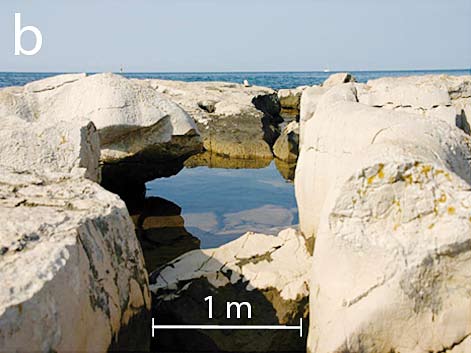Shore grykes along the western Istrian coast
DOI:
https://doi.org/10.3986/ac.v40i1.26Abstract
We provided new data on topography, morphology and physical/chemical parameters (pH, T, NO2-, Ca2+, PO43-, NaCl) collected in several shore grykes along the Northwestern Istrian coast, between Savudrija and Zambratija. Six transects, eachcontaining four to five pools, have been surveyed. Three morphological zones have been identified along the selected profiles. Morphological features of the shore grykes along the western Istrian coast are, in fact, closely related to the local tide. High-level pools are affected by karstic processes, and the surface is usually smooth. At their bottom, terrigenous deposits, mainly terra rossa, occur. Seaward, bioerosion prevails and at the bottom of the grykes, sand and rounded pebbles have been found. Chemical/physical parameters suggest that grykes located at lower altitudes are affected by seawater factors, while pools located at increasing altitudes are affected mainly by rainfall and consequentially freshwater or saltwater remaining from rainfalls or storm events. Shore gryke genesis is strongly controlled by geological weakness, along whichthey develop. Their origin is in fact due to local tectonics, while their development is related to the active vertical tectonic subsidence of the study area. Pools located at higher altitudes are mainly affected by solution karst processes, but due to the tectonic downdrop of the area, when the grykes come in contact withsea, they are gradually shaped by marine processes.
Downloads

Downloads
Published
How to Cite
Issue
Section
License
Authors guarantee that the work is their own original creation and does not infringe any statutory or common-law copyright or any proprietary right of any third party. In case of claims by third parties, authors commit their self to defend the interests of the publisher, and shall cover any potential costs.
More in: Submission chapter




